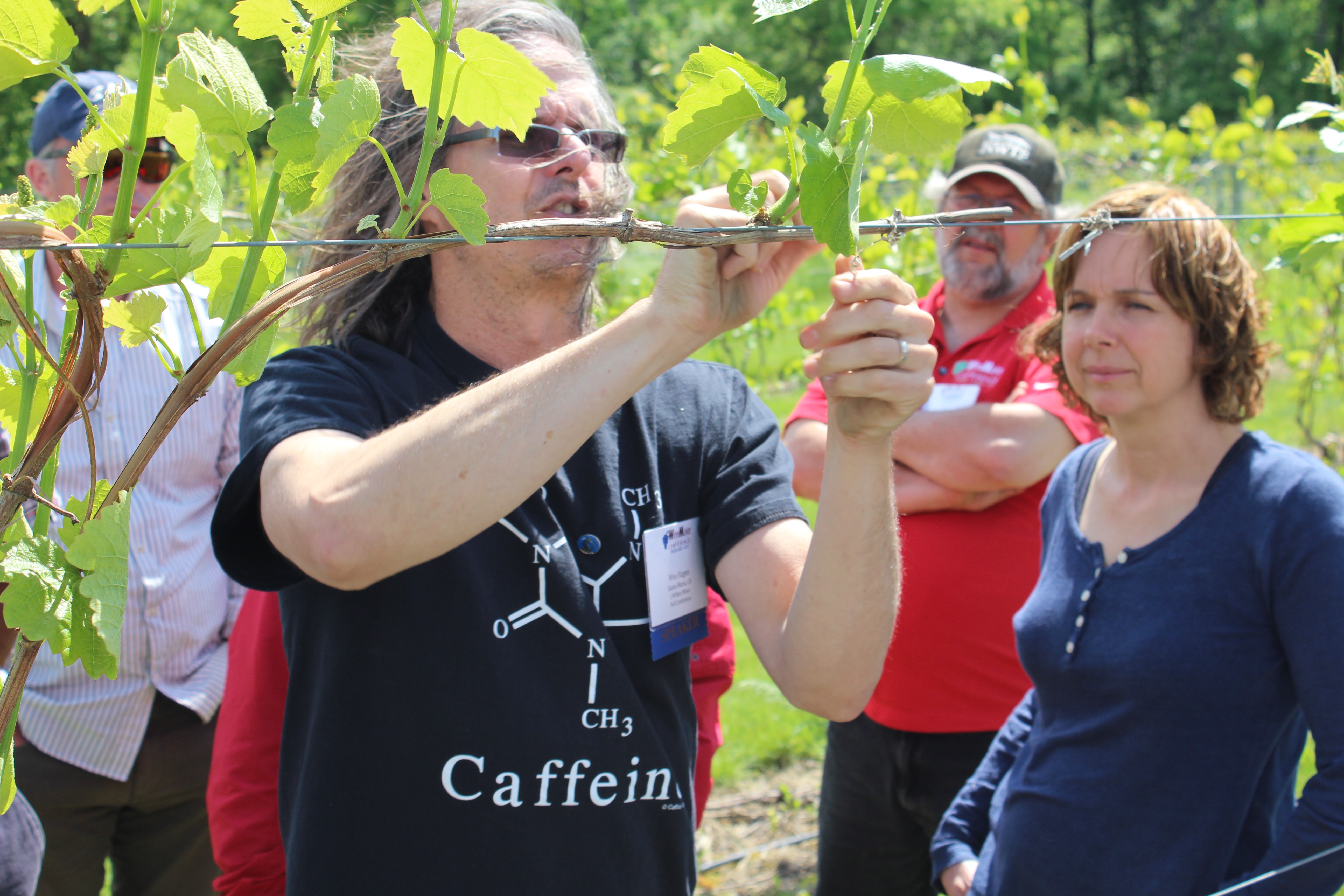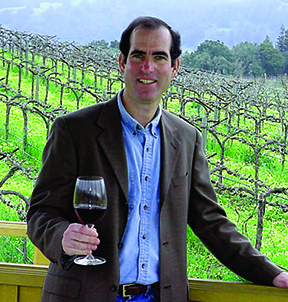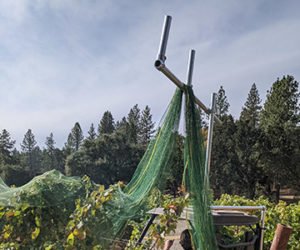 As viticulturists we adjust our farming to the climate and the vintage. Any given day we might be watering, fertilizing, positioning shoots, pulling leaves, applying fungicide, or (if all goes relatively smoothly) harvesting. For most home vineyardists, even finding time to work in the vineyard can be a challenge.
As viticulturists we adjust our farming to the climate and the vintage. Any given day we might be watering, fertilizing, positioning shoots, pulling leaves, applying fungicide, or (if all goes relatively smoothly) harvesting. For most home vineyardists, even finding time to work in the vineyard can be a challenge.
Growing grapes tends to be a reactive process. We see how our vines are responding to the soil, climate, and human interaction, and we react. Every decision we make impacts the vintage and the quality of our wines. While it’s easy to make a plan for a year’s farming in the vineyard, it’s almost impossible to stick with it. Weather fluctuates, rain comes and goes, frost pops up when we least expect it. We may have to deal with heat waves, cold streaks, pests of all shapes and sizes, labor issues, mildew, equipment failure — and of course we need to juggle our busy schedules just to find a few hours each week to get into the vineyard.
But backyard grape growing does not have to be purely reactive in nature. It’s good to have a plan that we can stick to as long as the year cooperates. Let me suggest this: Sometimes it’s better to stick with your vineyard plan than to constantly tweak it to compensate for a week’s weather. Of course we want to observe the vineyard conditions and adapt — but we don’t want to be led into poor decisions by a few days’ abnormal weather or by the condition of a few vines in the vineyard. Every area has challenges and hardships, and I’ve seen just about all of them. What I’ve learned from 24 years of viticulture and seeing vine hardship is that the grapevine has an amazing capacity to recover and do its job. You have to believe, even in the worst moments, that the vineyard knows what it is doing and just needs a nudge or some effort from you to produce a good crop.
Here are Wes Hagen’s vineyard management basics:
• Have a plan. Be flexible enough to adapt, but not so hasty that you abandon standard cultural practice on a whim or because of strange weather.
• Observe the vineyard. Look as often as you can for patterns — never make decisions based on a single vine. Take the ‘average’ of all vines in a field when making decisions on how to farm the whole vineyard. Or even better, farm every individual vine to its best advantage. Spot fertilize the struggling vines, replace a vine that shows virus, pull a different amount of leaves from the canopy depending on vigor.
• Stay informed. There are tons of great websites and print books and magazines that can keep you up to date on winegrowing, science and new strategies for growing winegrapes. Besides reading each and every issue of WineMaker magazine, I recommend reading Wines and Vines for those that can’t get enough info, and for those that are considering a run at a commercial production, don’t forget one of my favorite pubs: Wine Business Monthly. If you don’t own a copy of Dr. Smart’s Sunlight Into Wine you are missing out on the book that revolutionized canopy management and heralded the modern viticultural age (and informed much of this article and my own winegrowing success). The Internet can be a great place to gather information, read and to socialize. Participate in an online community like winepress.us (currently at over 23,000 subscribers) or winemakingtalk.com, or find a viticulture newsgroup. Focus on web resources that are peer-reviewed and scholarly, such as UC-Davis, Fresno State, Cornell, University of Minnesota, etc. Join (or start) a local winegrowing club so you can have another excuse to get together and drink your home wines and discuss what cultural practices and strategies have been more and less successful in your neck of the woods. Gather the information, see what works in your home vineyard and reject any info that fails; repeat and cherish the info that helps you grow better wine. Take good notes!
• Consistency is king. The greatest wines are made from vineyards with admirable consistency from vine to vine. Try to keep all vines manicured with similar vigor and crop load. Consistency provides uniform ripeness from berry to berry, cluster to cluster, vine to vine, row to row. Try to avoid Brix gaps (from vine to vine, cluster to cluster) greater than 2–3 °Brix. It’s hard to make great wine from a vineyard where some primary clusters measure 20 °Brix and others measure 28. You’ll get the green, herbaceous flavors from the underripe fruit and the jammy overripe notes from the too-ripe fruit. Just because the blend in the fermenter is 23.8 °Brix doesn’t mean there will be consistency of flavor.
• Focus on the good. You will always have a few vines in the vineyard that are ugly and will always underperform. The soil may be shallow, there may be a bit too much boron (or too little), or some kid may have dumped motor oil on the dirt five years ago. Don’t try to understand it or spend hundreds of dollars on tests. Spend your precious vineyard time fine-tuning the healthy parts of the vineyard. If the “sick” part of the vineyard grows each year, worry about it. But if it stays isolated (usually at the margins of the vineyard), don’t sweat it too much. You can try to replant a few vines, but expect them to have the same problem as the originals. If you pull them out, you may be adding a deeper margin to the vineyard and the vines a few rows in might suffer.
• Keep a notebook! Make sure you are documenting the practices you complete in the vineyard. It can be as simple as an entry like, “May 3, 2018: Finished first leafing pass on east side. Took approx. 30% of leaves and all laterals out. Left less than one leaf layer between the sun and clusters.” In this way you will be able to correlate your work with the success or failure of any vintage. If the wine is a hit you can replicate your success, and if it lacks something you can try to identify the problem and try different timing — if you identify the faults as vineyard-based.
• Use your notes. Be sure that you are referencing notes from previous years to help make a vineyard plan for next year. If you keep records, use them! Look for areas where you can be more efficient or really improve quality gaps that you perceive to be vineyard-related.
Post-Harvest Shutdown
After the fruit has been picked and crushed, there are a few more details that need to be attended to in the vineyard:
• Remove all fruit. Make sure all fruit, even ugly fruit and bird-pecked clusters/stems, have been totally removed from the vines. Fruit/stems that are allowed to stay on the vine will increase rot and mildew pressure the following year because the spores will overwinter on the vine and produce lots of new spores to start the cycle again in the Spring. Removing the fruit completely from the vineyard is preferable, but you won’t be adding much extra pressure by allowing the trash fruit to compost in the center of the vine rows.
• The hangover walkthrough. Make sure to do a vineyard walkthrough after your day of winemaking to determine all fruit has been harvested, a row has not been missed, equipment has been gathered, buckets/picking shears collected, and pickers aren’t passed out between rows (funny what an extra bottle of wine and hard labor might do to your friends). Nets should be rolled up and stored. There are moments when the pressures of harvest make us put off some final vineyard tasks. I find that those last tasks rarely get done if they are not completed immediately after a harvest day. You’ll feel much more comfortable after a day of harvest and winemaking knowing that the vineyard is all clean and the winery is orderly and sanitary. These are the details that help to make good wine great.
• Irrigate the vines. Give the vines a DEEP IRRIGATION if rainfall hasn’t already saturated the ground. After being freed from their burden of fruit, the vines go into a stage of strong root growth that will be easier for the vine if the soil is saturated. The vines will then turn their stores of nitrogen and carbohydrates into a form that can be saved for budbreak the following growing season. For these processes to succeed, the vines need to keep some leaves for photosynthesis, but you do NOT want to induce active vine growth with fertilization. Ten or more gallons per vine is not unreasonable if the soil is still dry. Turn the drippers on all night and let the vines soak up a nice long drink. They’ve worked as hard as you all year and deserve to wet their feet and relax for the winter.
Conclusion
The flavors and nuances of your homegrown wines are always more important that an arbitrary number granted by a magazine quiz. The online scorecard (link below) is only meant to give you a sense of how much study and care you are taking in your vineyard management. If you score low and are making delicious wines — don’t worry about it. Conversely, if you score high and are making wines that aren’t drinkable then you are likely over-educated and under-performing your vineyard tasks. The proof is always in the wine. Keep your eye on the prize and your nose in a glass.
Wes Hagen is the Winemaker at J. Wilkes Wines and readers can reach him at [email protected]. Find the quiz, cheat sheets, and scorecard at:
https://www.winemakermag.com/article/wes-post-harvest-quiz







